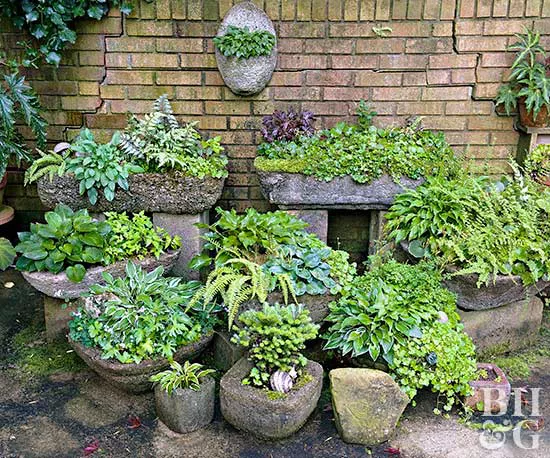Garden troughs can contain large woodland landscapes, others are small and whimsical, and some even hold miniature rock gardens. Each has a distinct personality, which is part of the appeal of troughs. Because you can change the soil mix, you can grow plants in a trough that you couldn't grow in your garden otherwise. You can make troughs from hypertufa, which is a mix of portland cement, perlite, and peat moss.
Make your own hypertufa trough.
The grouping of troughs above contains mostly shade lovers. The center front trough is planted with a miniature fir; to the left is a miniature hosta. Second row, left to right: dwarf meadow rue (Thalictrum kiusianum) mixed with miniature hostas; holly-fern woodsia (Woodsia polystichoides) with Hosta 'Blue Mouse Ears' and rockfoil (Saxifraga veitchiana); and two troughs with bulbous fern, miniature hostas, and rockfoil. Back row against wall, left to right: miniature forget-me-not and Japanese painted fern; more rockfoil, Saxifraga paniculata' Silver Velvet', and self-seeded violets.
See the best plants for trough gardens.
Cold Comfort
A handmade hypertufa trough needs to cure in a shady area for 30 to 60 days. Once cured, it can be left out in freezing temperatures as long as it is elevated off the ground. A shallow version, such as this one, holds low-growing succulents and groundcovers.
See the easiest groundcovers you can grow.
Soothing Scene
Nestled alongside a Japanese maple and a patch of wild ginger (Asarum canadense), the rock garden trough is filled with tufa rock, miniature hostas, and Kenilworth ivy (Cymbalaria muralis 'Alba Compacta').
Step Up
Use leftover hypertufa mixture to create feet for your troughs to keep them off the ground. Add your favorite bonsai varieties and a lawn ornament to keep your trough garden looking festive.
Mini Woodland
Load up a hypertufa trough with dwarf conifers, succulent sedums, and cascading groundcovers. Add in different decorative rocks of your choosing.




















